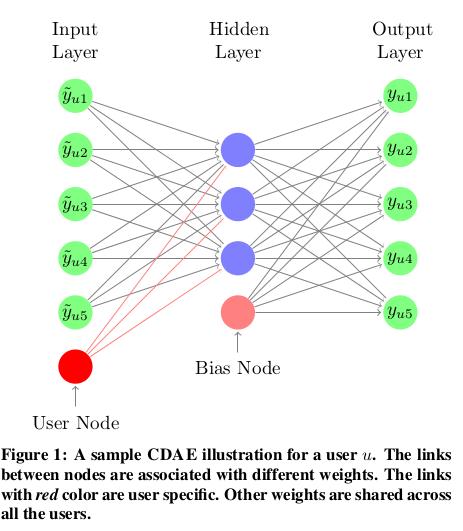请参考LibRec https://mp.weixin.qq.com/s/qwDIvXlpP5UIBTwtpqhYsg
本文作者已经公开了代码, 需要在TensorFlow上运行https://github.com/jasonyaw/CDAE.
本人理解, 同另一篇文章http://nuoku.vip/users/2/articles/86 的区别在于 本文在input层加入了表达用户的bias vectors, 本质是将大家一致的input层的bias vector, 变成了user-specific bias vector.
所以本文依旧是在DAE的结构上下功夫, 另本文从技术的角度对推荐系统作了一个总结,很精辟,值得学习(如从Model的角度,从loss function角度,从Mapping function角度)

| 文献题目 | 去谷歌学术搜索 | ||||||||||
| Collaborative Denoising Auto-Encoders for Top-N Recommender Systems | |||||||||||
| 文献作者 | Yao Wu Christopher DuBois Alice X. Zheng Martin Ester | ||||||||||
| 文献发表年限 | 2016 | ||||||||||
| 文献关键字 | |||||||||||
| Recommender Systems; Collaborative Filtering; Denoising Auto- Encoders; 有关于模型的分类总结; DAE | |||||||||||
| 摘要描述 | |||||||||||
| Most real-world recommender services measure their performance based on the top-N results shown to the end users. Thus, advances in top-N recommendation have far-ranging consequences in practical applications. In this paper, we present a novel method, called Collaborative Denoising Auto-Encoder (CDAE), for top-N recommendation that utilizes the idea of Denoising Auto-Encoders. We demonstrate that the proposed model is a generalization of several well-known collaborative filtering models but with more flexible components. Thorough experiments are conducted to understand the performance of CDAE under various component settings. Furthermore, experimental results on several public datasets demonstrate that CDAE consistently outperforms state-of-the-art top-N recommendation methods on a variety of common evaluation metrics. | |||||||||||